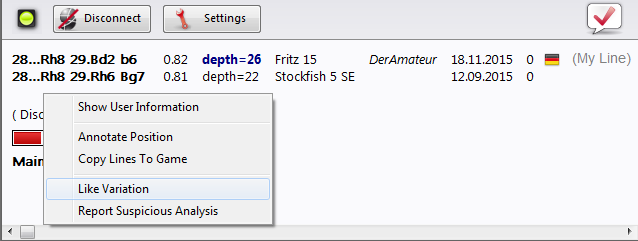|
Let’s Check context menu |

|

|
|
|
Let’s Check context menu |

|

|
Let’s Check context menu
Right clicking in the Let’s Check window opens a context menu with various functions:

Show User information: This displays information about the user whose analyses have been sent to the Live Book. This is only possible if he has a user name on the Playchess.com server. In the dialog window there is a section containing the statistics. This shows the number of points the user has, and the number of variations he has won. The number of points depends on the value of the positions that have been analysed. The window only contains the total points reached. The number of variations is a number that can change at any time, if another user stores a deeper analysis for this variation. The window also shows how many Likes the user’s lines and comments have been given by other users.
Annotate Position: This inserts the analysis of other users into the game notation. Right click in the Let’s Check window and then click on “Annotate Position”. This copies the analyses from the Let’s Check database nested up to four levels deep. Only variations are used that have at least a “green level”.
After clicking on the function the evaluation is copied into the notation.
Copy lines to notation: This copies all existing variations (not just the selected variations) into the notation.
The following is an example of copying lines into the notation:
What does “Engine/Game Correlation” mean at the top of the notation after the Let’s Check analysis?
This value shows the relation between the moves made in the game and those suggested by the engines. This correlation isn’t a sign of computer cheating, because strong players can reach high values in tactically simple games. There are historic games in which the correlation is above 70%. Only low values say anything, because these are sufficient to disprove the illegal use of computers in a game. Among the top 10 grandmasters it is usual to find they win their games with a correlation value of more than 50%. Even if different chess programs agree in suggesting the same variation for a position, it does not mean that these must be the best moves. The current record for the highest correlation (October 13th 2011) is 98% in the game Feller-Sethuraman, Paris Championship 2010. This precision is apparent in Feller’s other games in this tournament and results in an Elo performance of 2859 that made him the clear winner.
Like Variation/Report Suspicious Analysis: These functions send a report about the evaluation of the selected variation to the server. This is also displayed in the Chat window of the Live Book.